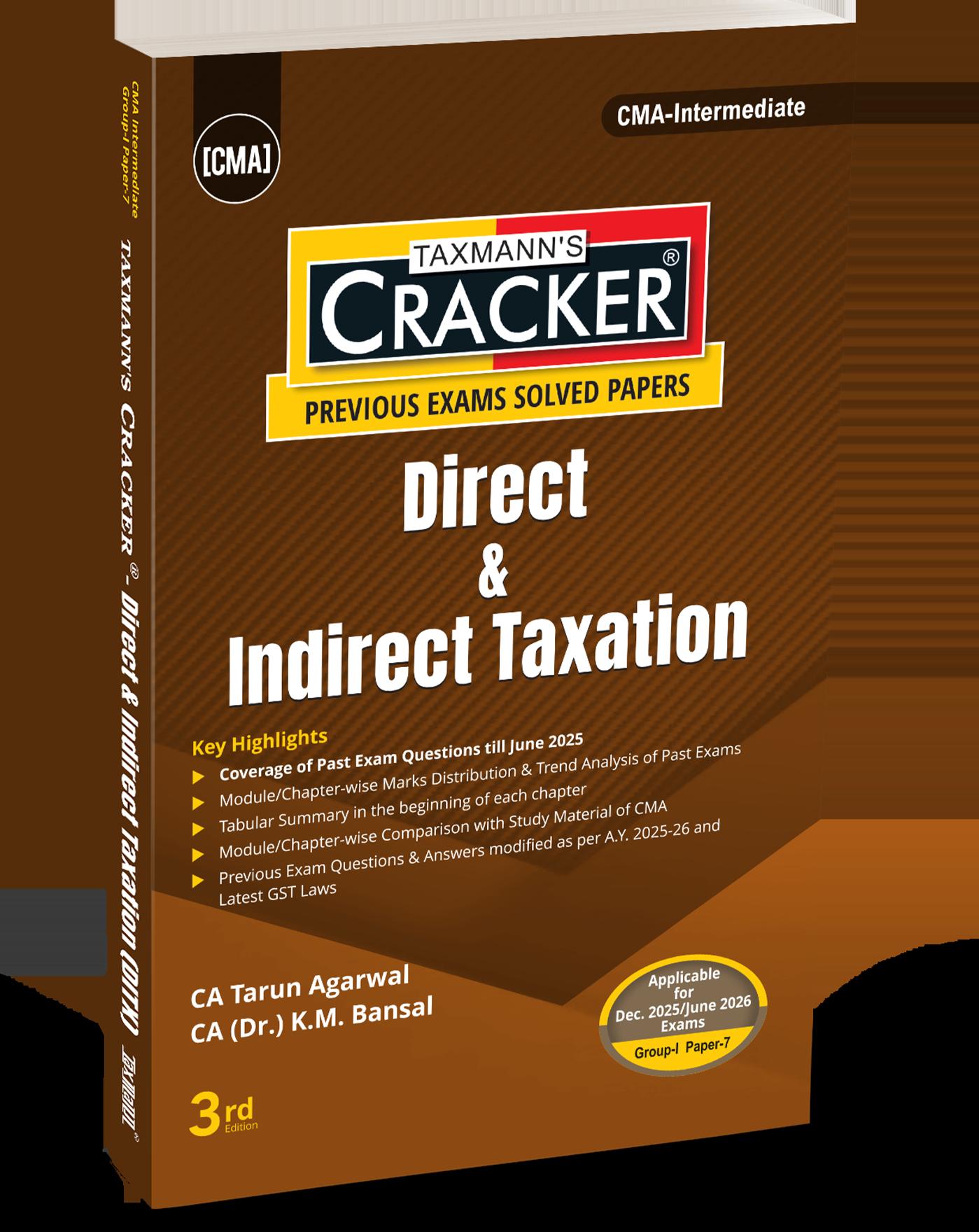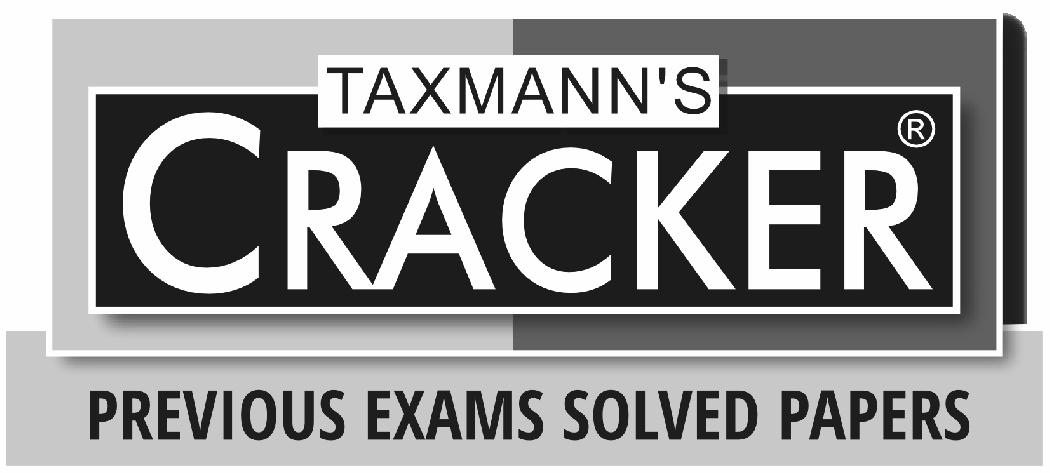





© All rights reserved
Price : ` 695
Third Edition : July 2025
Published by :
Taxmann Publications (P.) Ltd.
Sales & Marketing :
59/32, New Rohtak Road, New Delhi-110 005 India
Phone : +91-11-45562222
Website : www.taxmann.com
E-mail : sales@taxmann.com
Regd. Office : 21/35, West Punjabi Bagh, New Delhi-110 026 India
Printed at :
Tan Prints (India) Pvt. Ltd.
44 Km. Mile Stone, National Highway, Rohtak Road Village Rohad, Distt. Jhajjar (Haryana) India
E-mail : sales@tanprints.com
Disclaimer
Every effort has been made to avoid errors or omissions in this publication. In spite of this, errors may creep in. Any mistake, error or discrepancy noted may be brought to our notice which shall be taken care of in the next edition. It is notified that neither the publisher nor the author or seller will be responsible for any damage or loss of action to any one, of any kind, in any manner, therefrom. No part of this book may be reproduced or copied in any form or by any means [graphic, electronic or mechanical, including photocopying, recording, taping, or information retrieval systems] or reproduced on any disc, tape, perforated media or other information storage device, etc., without the written permission of the publishers. Breach of this condition is liable for legal action.
For binding mistake, misprints or for missing pages, etc., the publisher’s liability is limited to replacement within seven days of purchase by similar edition. All expenses in this connection are to be borne by the purchaser. All disputes are subject to Delhi jurisdiction only.

Module-wise Marks Distribution I-5
Previous Exams Trend Analysis (Syllabus 2022) I-7
Module-wise Comparison with Study Material I-13
SECTION A DIRECT TAXATION
MODULE 1 BASICS OF INCOME-TAX ACT
CHAPTER
MODULE 2 HEADS OF INCOME
CHAPTER
CHAPTER
CHAPTER
MODULE 3 TOTAL INCOME AND TAX LIABILITY OF INDIVIDUALS AND HUF
CHAPTER
MODULE
CHAPTER 6.3
CHAPTER 6.4
COMPUTATION OF ASSESSABLE VALUE AND DUTIES 6.24
Paper: June 2025 P.1

Working Notes:
(1) Taxable Gratuity: Particulars ` `
Gratuity received 25,00,000
Less: Exemption (lower of the three below)
(a) Actual Amount 25,00,000
(b) Monetary Limit 20,00,000
(c) 15/26 × (95,000 + 1,14,000) × 25 Years 15,34,615 (15,34,615)
Taxable Gratuity 9,65,385
(2) Taxable Leave Encashment: Particulars ` ` Leave Encashment received 12,00,000
Less: Exemption (lower of the three below)
(a) Actual Amount 12,00,000
(b) Monetary Limit 25,00,000
(c) 10 Months total salary (9,50,000 + 30% × 1,14,000) 9,84,200
(d) [(25 × 1) – 12] × (95,000 + 3,420) 12,79,460 (9,84,200)
Taxable Gratuity 2,15,800
(3) Taxable Commuted Pension:
Less: Exemption 1/3 (since gratuity is received) (1,50,000) Taxable Gratuity 3,00,000
2.2
INCOME FROM HOUSE PROPERTY
A QUICK REVIEW
SEC. 22: CHARGING SECTION:
Charge on Annual Value
Property consisting of Building and Land appurtenant thereto
Not used for own business pro ts of which are taxable
Owner (including deemed owner)
SEC. 23 CALCULATION OF ANNUAL VALUE:
(1) Let out property:
Fair Rent or Municipal Value (WEH) compared with Standard Rent (WEL) ER (Expected Rent)
If Actual Rent > Expected Rent, Gross Annual Value = Actual Rent
If Actual Rent < Expected Rent Owing to vacancy Yes: Gross Annual Value = Actual Rent
NO: Gross Annual Value = Expected Rent
Net Annual Value = Gross Annual Value (-) municipal tax paid and borne by Assessee in Previous Year (Not Advance municipal tax)
(2) Two Self-occupied or whole year vacant property: Annual Value = NIL (Only Individual/HUF)
(3) Property let out for a part of the year and self-occupied for part of the year: Whole year ER will be compared with Actual Rent of the let out period and municipal taxes for whole year can be claimed as deduction.
(4) Deemed let out: Gross Annual Value = Expected Rent
(5) For property held as stock in trade: If whole or any part of the property may not be let out during whole or part of the year, then annual value of such property or part shall be taken as NIL. But this bene t is available only for a period of two years from the end of the nancial year in which certi cate of completion is received from competent authority.
SEC. 24: DEDUCTIONS:
(
a) Standard deduction: 30% of Annual Value
(b) Interest on Loan for HP:
Let out/Deemed let out: NO LIMIT
Self-occupied:
Loan for repair: Max. 30,000
Loan for Purchase: If after 1-4-1999; Max. 2,00,000, otherwise: Max. 30,000.
Loan for Construction: If after 1-4-1999 and construction completed in 5 yrs from the end of FY in which loan taken: Max. 2,00,000, otherwise: Max. 30,000.
Note: No deduction for interest on loan for self-occupied property under default tax regime
Interest for pre-construction period: Interest from date of loan or Start of Construction (whichever is later) up to 31st March preceding date of completion of construction.
Deduction: In 5 equal instalments from year of completion.
SEC. 25:
Interest payable outside India and Tax not Deducted at Source or not remitted then No deduction allowed
2.50
SEC. 25A:
Deduction of 30% from both Arrears of rent and unrealized rent
SEC. 26:
Co-ownership: Respective shares taxable individually
SEC. 27:
Deemed ownership:
Holder of Impartible estate
Member of Co-operative housing society/ company/ AOP/BOI to whom house is alloted
Person satisfying conditions of section 53A of Transfer of Property Act, 1882
Right in a property u/s 269UA(f) (Lease of 12 or more years)
Transferor of property to spouse/minor child without adequate consideration:
Except:
Minor married daughter
Agreement to Live apart from spouse Exemptions from House Property Income:
(i) Income from property held under trust for charitable or religious purposes [Section 11].
(ii) Income from house property belonging to a Registered Trade Union [Section 10(24)].
(iii) Income of an authority constituted under any law for the time being in force for the marketing of commodities; any income derived from the letting of godowns or warehouses for storage, processing or facilitating the marketing of commodities [Section 10(29)].
(iv) The annual value of any one palace in the occupation of an ex-ruler [Section 10(19A)].
(v) Income from house property belonging to a local authority [Section 10(20)].
(vi) Income from property of an authority constituted for the purpose of planning, development, or improvement of cities, towns and villages [Section 10(20A)].
(vii) Income from property of the approved scienti c research association subject to ful llment of certain conditions [Section 10(21)].
(viii) Income from property of a games association [Section 10(23)].
(ix) Income from property in the case of a person resident of Ladakh. [Section 10(26A)].
(x) Income from property of a political party [Section 13A].
PAST EXAMINATION QUESTIONS
OBJECTIVE QUESTIONS
Q. 1 Where any unrealized rent, earlier allowed as deduction is realized subsequently, the deduction available thereof is ___________.
[June 2014, 1 Mark]
Ans. 30%
Q. 2 Mr. Laxman occupied his apartment till December 2024 and thereafter occupied the quarters provided by the employer. The apartment of Mr. Laxman was let out at ` 20,000 per month from 1st January, 2025. The annual value of the property would be:
(a) ` 60,000
(b) ` 2,40,000
(c) ` 1,80,000
(d) NIL
Ans. (a) ` 60,000.
[June 2016, 1 Mark]
Q. 3 Deduction available under section 24(a) is ____________________ of NAV.
(a) 30%
(b) 50%
(c) 15%
(d) 70%
Ans. (a) 30%
[June 2017, 1 Mark]
Q.4 Generally, income is taxable under the head, house property only when the assessee is the ___________ of such house property.
[June 2017, 1 Mark]
Ans. Owner
Q. 5 When unrealized rent is received based on court decree but at the time of receipt the property was not owned
by the assessee, it is taxable under the head ___________.
[Dec. 2017, 1 Mark]
Ans. Income from house property.
Q. 6 When unrealized rent of ` 50,000 in respect of a let-out property is realized subsequently, the amount liable to tax would be ` _______________.
[Dec. 2017, 1 Mark]
Ans. ` 35,000.
Working Note:
Taxable Amount = Unrealized Rent –Standard Deduction = 50,000 – (50,000 30%) = ` 35,000.
Q. 7 Which of the following is not a case of deemed ownership of house property?
(a) Transfer to spouse for inadequate consideration
(b) Transfer to minor child for inadequate consideration
(c) Co-owner of a Property
(d) None of the above
[June 2018, 1 Mark]
Ans. (c) Co-owner of a Property
Q.8 Income from sub-letting of a house property by a salaried employee is taxable under the head ________.
[June 2018, 1 Mark]
Ans. Income from Other Sources.
Q.9 Ram commenced construction of residential building on 1-4-2019. Interest on housing loan up to 31-32024 was ` 4,40,000. Interest for the period from 1-4-2024 to 30-9-2024 (being the date of completion of construction of the residential house)
®
2.52
SECTION A : DIRECT TAXATION
was ` 60,000. Interest for the period from 1-10-2024 to 31-3-2025 amounts to ` 50,000. How much is the interest eligible for deduction under section 24 for the Assessment Year 2025-26 for this let out property?
(a) ` 1,50,000
(b) ` 1,98,000
(c) ` 5,00,000
(d) ` 1,00,000
[Dec. 2021, 1 Mark, Modi ed]
Ans. (b) ` 1,98,000
Working Note:
Pre-construction Interest = 4,40,000/5 = ` 88,000
Current Year = 60,000 + 50,000 = ` 1,10,000
Total Interest allowed = ` 1,98,000.
Q.10 When the actual rent is (per annum) ` 72,000, fair rent is ` 96,000 and standard rent is ` 84,000 and no property tax has been paid, the chargeable income from house property is ` _______ . [Dec. 2021, 1 Mark]
Ans. 58,800.
Working Note:
Expected Rent = ` 84,000
Actual Rent = ` 72,000
Gross Annual Value = ` 84,000
Net annual Value = 84,000 – 0 = ` 84,000
Taxable Income from House Property = 84,000 – (30% 84,000) = ` 58,800.
Q.11 Mr. A let out a property for a monthly rent of ` 30,000 during the whole of the nancial year 2024-25. He paid municipal tax of ` 60,000 in December, 2024 for nancial years 2022-23, 2023-24 and 2024-25 being ` 20,000 per annum. How much is the income under the head ‘house property’ taxable in the hands of Mr. A?
(a) ` 3,40,000
(b) ` 3,00,000
(c) ` 2,10,000
(d) ` 1,92,000
[Dec. 2022, 1 Mark, Modi ed]
Ans. (c) ` 2,10,000
Working Note:
Gross Annual value = 30000 × 12 = ` 3,60,000
Less: Municipal Tax paid ` (60,000)
Net Annual Value ` 3,00,000
Less: Standard Deduction 30% ` (90,000)
Taxable House Property income ` 2,10,000
Q.12 What is the maximum limit for deduction in respect of interest on money borrowed in the case of selfoccupied property?
(a) ` 1,00,000
(b) ` 2,00,000
(c) ` 3,00,000
(d) ` 1,50,000
[June 2023, 1 Mark]
Ans. (b) ` 2,00,000.
Q. 13 The maximum of interest on loan borrowed for the purpose of repair of let-out building deductible under section 24 is _________.
[June 2023, 1 Mark, Modi ed]
Ans. ` 30,000.
Q. 14 Chitra (age 33 years) received ` 5,00,000 by way of arrear rent from a nationalized bank in April, 2024. The arrear rent relates to Assessment Years 2023-24 and 2024-25. How much of arrear rent is chargeable to tax for the Assessment Year 2025-26?
(a) NIL
(b) ` 1,75,000
(c) ` 3,50,000
(d) ` 5,00,000
[Dec. 2023, 1 Mark, Modi ed]
Ans. (c) ` 3,50,000
Q. 15 Sunil, employed in a bank, availed housing loan in the nancial year 202122. The interest on money borrowed for construction of residential house (self-occupied by him) for the previous year 2024-25 was ` 2,20,000. He has opted for section 115BAC. How much of interest on housing loan is deductible?
(a) NIL
(b) ` 30,000
(c) ` 2,00,000
(d) ` 2,20,000
[Dec. 2023, 1 Mark, Modi ed]
Ans. (a) NIL.
Q. 16 Pre-construction interest on housing loan is eligible for__________ annual instalments.
[Dec. 2023, 1 Mark]
Ans. 5 ( ve).
THEORY QUESTIONS
Q. 1 How is the unrealized rent dealt with in annual value determination of a house property under the Income-tax Act, 1961? What are the conditions to be satisfied in this regard? [June 2015] [3 Marks]
Ans.
The amount of unrealized rent is not to be includible while determining the annual value of a property.
However, the following conditions are to be satis ed for excluding the unrealized rent:
(i) The tenancy must be bona de.
(ii) The defaulting tenant has vacated or steps have been taken to compel him to vacate the property.
(iii) The defaulting tenant is not in the occupation of any other property of the assessee; and
(iv) The assessee has taken all steps to institute legal proceedings for the recovery of unpaid rent or satis es the Assessing Of cer that the legal proceedings would be useless.
Q. 2 Write short note on Difference between unrealized rent and arrears of rent, realized in a subsequent year.
Ans.
[Dec. 2021, 3 Marks]
Difference between Subsequent collection of unrealized rent and arrears of rent
Unrealised Rent
Rent which could not be realized from the tenant, if subsequently realized, gets taxed in the PY of receipt.
Arrears of rent
If the assesses has increased the rent payable by the tenant retrospectively & there is dispute over such increase and later
Unrealised Rent
However, deduction shall be allowed @ 30% of such unrealized rent.
Taxable @ 70% of amount received
Arrears of rent on, the assessees receives the increased rent as arrears, is called arrears of rent.
It is taxable in the PY of Receipt Deduction of 30% is allowed on such arrears.
Taxable @ 70% of amount received
Q. 3 Write a short note on Deemed owner under House Property. [Dec. 2022, 5 Marks]
Ans.
1. Transfer to a spouse: If an Individual transfers any house property to his/her spouse for Inadequate consideration, such transferor is deemed to be the owner of the transferred House property.
2. Transfer to Minor Child: If an Individual transfers any house property to minor child for inadequate consideration, transferor is deemed to be the owner of transferred house property.
3. Holder of an Impartible estate: Holder of an Impartible estate (Impartible estate is a property which is not legally divisible) shall be deemed to be owner of all properties comprised in the estate.
4. Member of a Co-operative Society, etc: Member of a co-operative society, company or other AOPs to whom a building or part thereof is allotted or leased under a House Building Scheme of a society/company/association, shall be deemed to be owner of that building or part thereof allotted to him although the co-operative society/company/association is the legal owner of that building.
5. Person in possession of a property: A person who is allowed to take possession of any building or part thereof in part performance of a contract of the nature referred to in section 53A of the Transfer of Property Act shall be deemed owner of that house property.
6. Person having right in a property by way of lease for 12 years or more: A person who acquires any building by way of lease for a period of 12 years or more shall be deemed to be the owner of that building or part thereof.
NUMERICAL QUESTIONS
Q. 1 Mr. Lal is the owner of a commercial property let out at ` 60,000 per month. The Corporation tax on the property is ` 30,000 annually, 60% of which is payable by the tenant. This tax was actually paid on 15-4-2025. He had borrowed a sum of ` 40.00 lakhs from his cousin, resident in Singapore (in dollars) for the construction of the property on which interest at 8% is payable. He has also received arrears of rent of ` 80,000 during the year, which was not charged to tax in the earlier years. What is the property income of Mr. Lal for the Assessment Year 2025-26? Assuming he has opted out of default tax regime under Section 115BAC. [Dec. 2013, 5 Marks, Modified]
Ans.
Computation of Income from House Property of Mr. Lal for AY 2025-26
Particulars ` `
Gross Annual Value (60,000 12) 7,20,000
Less: Municipal Tax paid during the year NIL
New Annual Value 7,20,000
Less: Deduction u/s:
24(a) Standard Deduction (7,20,000 30%) 2,16,000
24(b) Interest on Housing Loan (40,00,000 8%) 3,20,000 (5,36,000)
Income from House Property before Arrears or Rent 1,84,000
Arrears of Rent received 80,000
Deduction u/s 25A: 30% of Arrears of Rent (24,000) 56,000
Total Income from House Property 2,40,000
Note: It is presumed that the tax has been deducted at source on the amount of interest payable outside India.
Q. 2 Ram and Shyam are joint owners (50% each) of a two storied house property (of equal area), the details of which are as follows:
(i) Ground Floor—let out at a monthly rent of ` 20,000.
(ii) First Floor—used for partnership business of Ram and Shyam.
(iii) Ram and Shyam received the following amounts in respect of another property which they had sold it on 31-3-2024:
* Unrealised Rent pertaining to FY 2023-24— ` 50,000
* Arrears of rent pertaining to FY 2023-24— ` 1,00,000
(iv) Municipal taxes paid for the entire house property—` 15,000 p.a.
(v) Interest on borrowings for the entire house property (Joint loan taken from HDFC)— ` 3,00,000.
Compute the income from house property and also explain how such income will be assessed in the hands of R and S. Assuming they have opted out of default tax regime under Section 115BAC. [June 2014, 6 Marks, Modi ed]
Ans
Computation of Income form House Property
Gross Annual Value: Annual rent received- Ground Floor (20,000 × 12) 2,40,000
Less: Municipal Taxes (15,000 × ½) (7,500)
Net Annual Value 2,32,500
Less: Deductions:
24(a) Standard Deduction 30%
24(b) Interest (3,00,000 × ½) 1,50,000 (2,19,750) Income from House Property before Arrears or Rent 12,750 Unrealized rent received
Arrears of Rent received 1,00,000 1,50,000
u/s 25A: 30% (45,000) 1,05,000
The income from House Property will be included in the hands of the individual members as per section 26. Hence, Ram and Shyam would show ` 58,875 each in their individual total income as income from house property.
Notes:
(a) The balance 50% municipal taxes and interest on borrowed capital in allowed as a business expenditure in their business income.
(b) Both unrealized rent and arrears of rent received during the year would be taxable in the hands of the assessee whether or not the assessee is the owner of the property (Section 25B).
(c) The portion of property used for business purposes, will not be considered for computing income from house property, business done by a partnership rm is business done by a partner of the rm. Hence, the Annual Let-out Value of the oor used for partnership business will not be considered while computing income from house property.
Q. 3 Mr. Nitin owns two houses, both of which are occupied by him for residential purpose. The details are given below:
Interest on loan for the nancial year 2024-25 1,10,000 1,70,000
Compute his income from house property and advise which house should be opted by him as self-occupied. Assuming he has opted out of default tax regime under Section 115BAC. [June 2014, 6 Marks, Modi ed]
Ans.
Nitin can opt for both the Houses as self-occupied and hence net annual value for both houses shall be NIL.
Computation of Income from House Property for AY 2025-26
Particulars
House I House II Self-occupied Self-occupied
Net annual value Nil Nil
Less: Deductions:
24(a) Standard Deduction 30% Nil Nil
24(b) Interest (3,00,000 × ½) (30,000) (1,70,000)
Income from House Property (30,000) (1,70,000)
Total Income from House Property = (2,00,000)
Note: In Case of House I loan is taken prior to 1-4-1999 so maximum interest deduction allowed is ` 30,000.
Q. 4 Mr. Singhania constructed a residential house property in Kanpur. Construction was completed on 1st April, 2024. The house was vacant from 1st April, 2024 to 31st July, 2024. The house was let out at rent of ` 7,500 per month from 1st August, 2024. Mr. Singhania obtained loan for the purpose of construction. Interest paid on such loan during two years prior to completion of construction amounted to ` 30,000. Interest paid during the year 2024-25 is ` 16,000. Fire Insurance premium paid is ` 2,000. Municipal value of the property has been assessed at ` 40,000. Annual corporation tax paid ` 3,000. Compute income under the head “Income from House Property” for Assessment year 2025-26. [Dec. 2014, 6 Marks, Modified] Ans.
Computation of Income from house property of Mr. Singhania for Assessment Year 2025-26
Particulars ` ` Reasonable Expected Rent = Municipal Value
rent (` 7,500 × 12)
Less: Vacancy allowance (` 7,500 × 3) (22,500) Actual Rent 67,500
Gross Annual Value = Actual Rent (Since Actual Rent is greater than Reasonable Expected Rent) 67,500
Less: Municipal tax paid (3,000)
Net Annual Value 64,500
Less: Deductions:
24( a )Standard deduction at 30% of net annual value (` 64,500 × 30%) 19,350
Particulars
24(b)Interest on loan for prior period (` 30,000/5) 6,000
Interest on loan for current year 16,000 (41,350) Income from house property 23,150
Q. 5 Raja is the owner of a residential house property having two independent oors of equal size in Chennai. The ground oor of the property has been let out to a tenant at rent of ` 15,000 per month from 1st June, 2024. The rst oor of the property is occupied by Raja for his residential purpose. Other particulars relating to the property are as follows:
p.a.
p.a.
municipal tax (50% paid)
Interest on loan taken for construction of property for the year 2024-25 30,000
Annual insurance premium 5,000
Compute income from house property of Raja for the Assessment Year 2025-26. Assuming he has opted out of default tax regime under Section 115BAC. [Dec. 2015, 7 Marks, Modi ed]
Ans.
Computation of income from house property of Raja for Assessment Year 2025-26
Particulars
First oor (rented) (50% of total area):
Municipal value (` 3,80,000 × 50%) 1,90,000
Fair rent (` 3,70,000 × 50%) 1,85,000
Standard rent (` 3,20,000 × 50%) 1,60,000
Expected rent is the higher of municipal value and fair rent, but restricted to standard rent 1,60,000
Rent receivable for the whole year (` 15,000 × 12) 1,80,000
Actual rent received due to vacancy (` 1,80,000 - ` 30,000) 1,50,000
Owing to vacancy the actual rent received is less than expected rent. Therefore, the actual rent received is the Gross Annual Value
Gross Annual Value 1,50,000
Less: Municipal tax – actually paid (` 57,000 × 50% × 50%) (14,250)
Net Annual value 1,35,750

